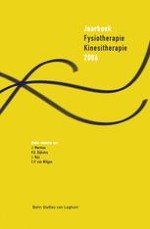Samenvatting
Gedurende de voorbije decennia werd een evolutie ingezet van overwegend ‘authority based’ kinesitherapie/fysiotherapie naar meer ‘scientific based’ kinesitherapie. Kinesitherapeutisch handelen was jarenlang sterk empirisch bepaald. Met de opkomst van ‘evidence based medicine’ steeg de vraag naar meer wetenschappelijke onderbouwing, ingegeven door de behoefte aan effectonderzoek. Betekent de vraag naar effectonderzoek dat fundamenteel georiënteerd onderzoek ten dienste van de kinesitherapie op de achtergrond dient te geraken? Aan de hand van voorbeelden ten aanzien van bewegingsanalyse en medische beeldvorming in relatie tot functionele anatomie wordt geargumenteerd dat de wetenschappelijke onderbouwing van de kinesitherapie zowel op een fundamenteel georiënteerde als op een klinisch georiënteerde pijler steunt. Ten eerste kan fundamenteel bewegingsonderzoek worden toegespitst op aan kinesitherapie of aan manuele therapie gerelateerde onderzoeksthema’s, zoals de onderbouwing van therapeutische onderzoeks- en behandelvaardigheden, ten voordele van de dagelijkse praktijk. Bij driedimensionale bewegingsanalyses met behulp van medische beeldvorming kan men letterlijk tot op het bot gaan, waardoor mogelijkheden worden geboden om artrokinematische details te onderzoeken en zo nodig therapeutische vaardigheden bij te stellen. Ten tweede zijn tal van bevindingen uit fundamenteel wetenschappelijk onderzoek nuttig in de voorbereiding van verantwoord manueel handelen en de afbakening van mogelijke contra-indicaties, zoals detailinformatie over de morfologie van de gewrichtsvlakken. Ten derde is er voor de kinesitherapie – dankzij haar affiniteit voor beweging – een actieve rol weggelegd in diverse multidisciplinaire en fundamenteel georiënteerde onderzoekslijnen van de bewegingswetenschappen. Aldus worden onder meer bijdragen geleverd tot de ontwikkeling van meetinstrumenten en meetmethodologie, die kunnen worden ingeschakeld ten behoeve van klinisch georiënteerd onderzoek.
